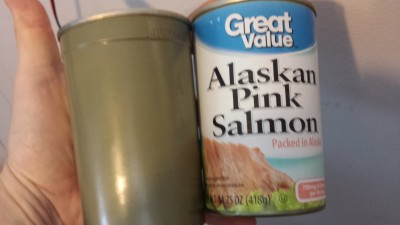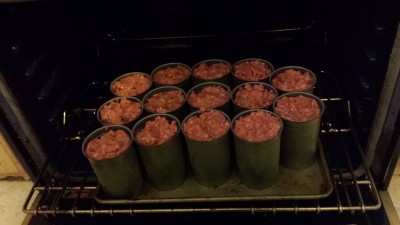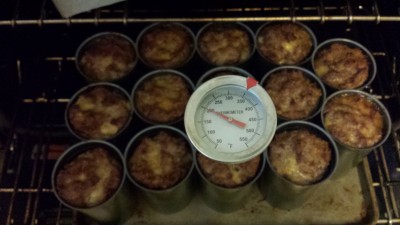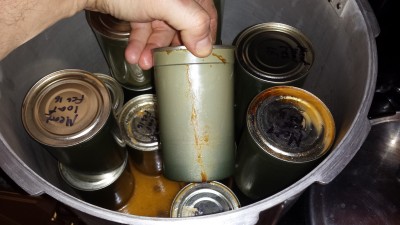Ives Way Can Sealer (Seen in my video)
Model 500 at Lehman’s $279
Model 900 At Wells Can $395CDN (approx $283USD) – This is apparently pre-adjusted for your individual can choice.
Salmon Cans (The 1 lb. are in the video)
Wells Can Company – $42CDN/36 $209CDN/216 (Currently $243.91 USD Shipped to Miami)
Presto Canner – $89.99 Amazon Prime
22 Wick Aluminum Butterfly Stove – St. Paul Mercantile $80
Personal Instruction in Home Canning & Tweaked Canning Equipment, Matched Cans:
Embarcadero Home Cannery
|
Ives Way Can Sealer Manual PDF Alaska Extension PDFs: Canning Meat in Cans Canning Fish in Cans Visual Inspection of Can Seams Add Variety to Home Canned Fish Assembling a Can Sealer |
Videos on Archive.org: Canning Fish in Cans Canning Game Meat in Cans Assembling a Can Sealer Montana Extension: |
This week will be my first installment into canning food in steel cans. Think of it this way. You haven’t eaten in a week. You just killed a deer. You really would like to be able to eat venison next week without having to kill another deer. What do you do?
The answer is can the meat. And that goes for a garden that produces more food that you can eat, catching more fish you can eat, and even swapping one of your extra kerosene/diesel lamps for a steer (because of course you bought a lot of kerosene lamps after my article on it).
This is my second installment on the larger subject of canning, so if you didn’t read the first one, where I successfully canned some vegetables using a Rocket Stove, definitely check that out. For that article I used traditional glass Ball jars. This week, canning food in steel, otherwise known as tin, cans, is much more complex. But these days I am making videos of my exploits, and as you an see, it is nowhere near as difficult as you might think reading printed directions. Will my cans last as long as store bought cans? Probably not. In fact as you’ll see, they are probably less than perfect, but as long as you cook your canned food there is no danger of getting the worst of canning mistakes, Botulism, but I’m getting ahead of myself…
Canning in cans is one of those things that a lot of people, especially serious preppers, learn and practice, but they don’t talk about it much. Lawsuits have brought the home canning industry to its knees, and almost to extinction. But you can still get can sealers, and you can still get cans. And it really isn’t expensive. Unfortunately there is a ton of misinformation out there about canning in cans, when you can find any information at all. But anyone who has ever canned in metal will tell you that they will never go back to glass.
Metal cans don’t smash, and they are freeze resistant (but not perfect). Glass jars eventually always break. In a survival situation, good luck with glass, but it has its uses, and glass jars are so available that it is a no brainer to keep some on hand. ! I have several hundred glass Ball jars myself, and another several hundred single use lids, and some reusable Tattler lids, as I explained in the last article. But though cans are not reusable, and dollar for dollar they don’t hold as much as glass, I’ll be storing a can sealer and several hundred steel cans as well, and I’ll use those first.
Don’t Get Botulism Please!
Canning food is safe. Well. Fairly safe. I’m not going to mislead you, because up until recently I thought canning was 100% safe. Then I had a conversation with Louis Nagel, the owner of Embarcadero Home Cannery. They are one of a very few small scale canneries still licensed in the US, and he explained to me that the dangers of home canning are misunderstood by most homesteaders. As I said in the video, he claims that home canning is a lot like a lottery. Eventually, if you do it long enough, you are going to hit a bad jar or can, that doesn’t look like it isn’t right. The actual cases of botulism every year are very small, but they do happen. The good news is that you can avoid any danger of botulism by cooking your canned food after you open it, as I’ll explain. Compared to the other variables in a post collapse survival, the dangers of canning are almost nothing, but you need to learn how to do it right, and the science behind why you need to do it right.
Mr. Nagel explained that even the wobble weight on home canning pots from Presto and All American is an issue, because it can vary the pressure where it is very sensitive at high altitude. His company has developed a pressure release that replaces that wobble weight. He also got very nervous when I asked him about canning food in #10 cans, and even quart sized 404 cans. Apparently there have been a lot of dumb people over the years who didn’t follow directions and got in big trouble with botulism. Then those people sued *everybody* who made the equipment they used. “There is no data for that” you will hear repeated quite often, because people are terrified to tell you something that you’ll do wrong, then sue them. At Embarcadero they actually sell the canning equipment at higher prices, but it comes with personal instruction and proprietary data. They will also help you walk through the certification process if you want to sell your canned food. I have not personally seen his proprietary materials, but if you are serious about home canning and you have the budget, I’d give Mr. Nagel a call.
The physics of safe canning are fairly simple. The bacteria C. Botulinum is present all around us, even in our stomachs. And while bacteria itself is not toxic, the toxin that it secrets is deadly. Botulimum toxin causes Botulism, which is a nasty disease like lock jaw that eventually locks up the heart. The Botulinum **bacteria** we ingest all the time, but it doesn’t effect us because everything in our digestive system constantly moves, so the bacteria is carried right through without having a chance to secret a quantity of toxin. In a festering can, where you didn’t kill the C. Botulinum, the toxin can build and build, and that is how it reaches deadly levels. You can’t give babies honey from a beehive until they are a year old because honey generally has a quantity of Botulinum toxin in it, for the same reason.
To kill C. Botulinum bacteria, the US standard for canning is to bring your food contents up to 250 degrees for 3 minutes. That means the inside of your food, which is why actual canning times are usually 60-120 minutes.
250 degrees Fahrenheit is no problem right? My oven goes up to 500, so I’ll just kill that sucker easy. Nope. Water is the problem. Most all food, and certainly all food you can, has water in it, and that water, at regular air pressure will not go over 212 without turning to steam. 212 will not kill the Botulinum bacteria. You have to use a pressure pot that is built for canning. Pressure keeps the water from turning to steam, so it reaches 250. Then you hold the pot at pressure for the time that it will take to guarantee that every part of your food reaches temperature enough to kill the bacteria.
Don’t skimp! The pressure, the altitude, and the times are crucial. You are not smarter than the scientists who have given us these recommendations. They have been testing cans for decades of all sizes, and just like the dynamics inside the pressurized chamber of a firearm are not always what you would expect, the dynamics of heat inside a pressure canner are generally not what you’d expect either.
That is why so little data exists for canning metal cans. There are so many sizes, and the canning companies themselves are very close to the vest with how they keep up the taste of the food, while meeting the 250 degrees for 3 minutes requirement.
Now for the good news! As I said above, if you don’t want to get Botulism, all you have to do is cook your canned food up to 185 degrees. I mistakenly said 140 in the video, which was probably just a brain fart, though I swear I remember reading it somewhere. Cooking to 185 will not kill the **bacteria**. It only kills **the toxin produced by the bacteria**. Technically it only needs to be at 185 degrees for 5 minutes, but that is all of the food, so you’ll want to make sure the whole thing is over 185, so most people suggest 30 minutes. That makes the food safe to eat, but not safe to store, because the bacteria will continue to produce toxin.
Choosing a Can Size
This article is about 1 lb. salmon cans. You’ll see these cans at your local grocery store in the canned fish section. According to the Alaska Extension Service (I linked the PDF above), you should can these at 10 lbs. for 115 minutes. I haven’t noticed a degradation in the quality of the taste at more time, so I leave them in for 2 hours, and in my Presto I run them at 15 pounds, or whatever I am getting from my heat source, even though I am at dead sea level in South Florida. If you live at above 2,000 feet, beware that at least 15 pounds of pressure is usually required, and you’ll need some serious BTUs to get there. At sea level on my Butterfly 22 wick stove, you’ll see in the video that I got 14 lbs.
The only source I know for these cans is Wells Can Company. These cans are very popular in Alaska, and it appears the home canners from the region rely on Wells to get them acceptable prices. In the video I think I said these cans are like $3 each, but that reference was back when the Canadian dollar was very strong, and for some reason shipping was much more as well. I just did an order with Wells for a case of 216 cans, and it came to $243.91 in US dollars. Mr. Nagel from Embarcadero is a fan of the 8oz sloped can, and he sells them. I have 5 children, so seldom am I going to have a meal where I don’t need at least the meat in one can to offset beans, rice and bread that will make up the majority of my survival food.
As I explained in the video, the advantage to the slope sided cans it that they stack. The 6 pack of 36 one pound cans comes all taped together, and it takes up the space of less than two 12 packs of quart Ball jars. Straight sided cans don’t stack, so not only do you end up spending a ton on shipping, because so many boxes have to come in comparison to slant sided cans, those boxes are very light and very fragile, and in my experience, the cans are always dented, even though the can companies pack them pretty good.
These were the charges for the 6 pack of 36 one pound salmon cans from Wells Can:
Leaky Cans = What?
As I’ve tried to explain with all of my articles here, this has been a learning process for me. My goal is not to instruct you in proper practices that always work. What I can tell you about canning food in cans is that there is a very quiet volume of preppers who take what is coming very seriously, and they all can food in metal cans. There are farmers in Iowa who have thousands of these cans stored, because they expect to be able to fill them when the time comes. Right now that Ives Way can sealer is available at Lehmans, but when this batch runs out, they will be gone for months, as they were about 6 months ago. From what I have heard, Ives Way is trying to get some CNC machines in now, but I don’t think we have a ton of time left.
In the pictures below here I have included a picture of some cans that were in my canner for 2 hours at 15 pounds. After I ran that salmon from the video, I decided to make some meatloaf, using the oven cook method, so I could show you that it seems to work. But this batch, like **every batch** I have run through the canner, had some leakage. All the seals on all the cans look the same, so identifying problem cans prior to cooking is really impossible. For all I know, **all of these cans are going to eventually fail** because my rollers are not adjusted properly. Remember that even if you have a leaky can, you just sterilized the inside contents, and the leak may be tiny. It could take a year for bacteria to work its way in. Personally when I get cans that look like they leaked, I pull them, put them in the fridge and eat them within a couple weeks. But when I open the rest of these a year from now, two years from now, ten years from now, they may be spoiled.

This actual project of canning salmon is a joke. I pay $6 a pound with skin on, which I have to remove. This can is $2.24 at Walmart.
My point is that there is very little proper instruction out there. If you notice, I had to link to archive.org to show you the Alaska extension service videos, because they apparently removed them from their website. It was probably liability reasons. I absolutely will not plan to eat any of my home canned food without a sniff test and only after cooking it up to 185 degrees. These cans you see here I will make sure to heat, because that leakage means that there are food particles in my can seal, no matter what. I will note that both of the Alaska Extension Service manuals, for canning meat and fish in cans, said “Wipe cans if they are greasy.” The cans wouldn’t be greasy if something didn’t leak.
After the collapse, I’ll use cans to store food that I get in trade or by growing it, and that will be short term. For long term food storage, I do have some store bought canned food, but mostly my personal storage is dry. And as I explained in the video, this particular storage of food on my part with the salmon was just for the video. You can get the same amount of salmon, in the same can, for $2.24 at Walmart right now. I paid about $8 per can for the storage you see here.
Buying a Used Ives Way Can Sealer
As I said in the video, right now there are brand new Ives Way can sealers available at Lehmans. They seem to have the best price on the model that gives you the more common can options. As I write this, there is only one Ives Way sealer on Ebay, and it is like $40. From what I can tell, this is a really really really old model, and that has been the rule that I’ve seen over the years on Ebay.
In the second half of the can sealer video I show you a used can sealer I got on Ebay several months ago. It is a newer model, and as always was missing many of the crucial pieces that you absolutely need, as I demonstrate. It also was squeaky because nobody had oiled it, and it didn’t make a great seal even though I adjusted it pretty good. Sometimes you are just buying other people’s troubles, because they boogered their rollers trying to use the sealer without learning how to properly adjust it. The rollers are very soft steel, and they are a common source of failure. So just beware that you can waste money trying to save money. Sometimes you get lucky too though. Recently a guy ran 2 model 800 can sealers through, in the boxes, and one went for $90 and the other went for $150. They had all the pieces, and appeared to be unused.
The All American Can Sealer
I didn’t get into the All American for this article because it is significantly more expensive, and inventory on them is even more touch and go than on the Ives Way. I do have one that I’ll be trying at some point, but I haven’t gotten to it yet. The All American comes in one single can size, not with several sizes like the Ives Way. If you only plan to can with 8oz or 1 lb. salmon cans, according to Mr. Nagel, the All American is a better machine. You should probably contact him to buy one so that he can explain the pitfalls. They apparently have had some change of ownership over the years and with that have come some serious QC issues. The owner of Ives Way was actually the guy who turned me onto Wells Can and the salmon cans, and I don’t think I will be convinced that there is a better choice than the Ives Way. Embarcadero also sells those, for $100 more or so, but as I said above, he not only gives you proprietary data, he also includes some extra shims for the bottom plate to make the cans seal more reliably.
Pressure Stoves vs. Wick Stoves
You’ll see in the video that I used my aluminum 22 wick Butterfly stove for this project that I covered a few weeks ago. Within a few weeks I hope to get out an article on pressure stoves that run on the same diesel fuel that I run in the butterfly, but I’ll tell you that I don’t think there is a big advantage. That goes double for a propane stove, and quadruple for a turkey fryer propane stove. Fuel conservation is to me a very important concern. Once what you have is gone, it’s gone, and fossil fuels are sooooo much more convenient to cook on than any other fuel. I find that the wick stoves are just at the number of BTUs you need to can, and I’ve even used the 16 wick successfully to keep my pot over 10 lbs.
Community Can Sealers from China
I’d also like to mention before closing this article that I have ordered a couple of electric can sealers from China, and they are due in soon. Speaking to Mr. Nagel about them, he said that in his perspective, they aren’t even an option. Can sealers in the US have to be certified by the US Government, and the companies that make them are forced to carry monstrous insurance policies. So for a commercial cannery, import machines are not an option. I’m not exactly a government bootlicker, and I don’t intend to ever sell my cans or even to feed them to someone not in my immediate family, so I really don’t care about all that stuff. From what I have seen, there are a bunch of people out there grouping up into what could eventually be surviving communities, after the great reckoning arrives. You can get a US made electric can sealer for home canning. But an electric can sealer from All American is thousands of dollars, for one single sized can. Budgets are an issue. I’ll report back on these electric Chinese sealers if they work. If a group of people went in on a sealer, whether it is for pressure canning like these cans, or #10 cans for dry storage, they could be a great buy. Most of my readers here are not in this mental space, and I understand that, but I do have some very serious readers here as well. These are all fairly new concepts for most people and I am trying to introduce to you what hundreds of thousands of people who woke up years ago already know. Canning food in steel cans is very reliable when you take the time to test and create a system. An Ives Way can sealer is really all you need, and a Presto canner. Just follow the directions, and remember to heat your canned food before you eat it.




Can sealers are the dream, but I found something that works well until I can afford one (or convince others to go in.) It isn’t a permanent seal, but for a much smaller investment to get a seal on #10 cans, there is an awesome product called “That Seals It!” (no joke) that you can use to vacuum seal opened #10 cans. You can use it with a food sealer or with a manual pump if you’re off grid. It’s perfect for the dehydrated food, jerky, or brown sugar that never dries out. You can buy it on amazon. I’ll try to post a link below. Game changer for us!
https://www.amazon.com/dp/B07SHXV2M6
I like stalking our cupboards with extra food in case of an emergency one day. The majority of this food storage is in cans. We try to rotate the cans out frequently so they do not sit for too long on the shelf. Thanks for this information about can sealers. This is a great idea to extend food shelf life.
What about storing food in glass or plastic jars with screw on or clamp on lids, that were bought in a store with food in in them, after the original contents are used?
Relating to leaking jars, I started doing some some research on canning (I’ve made jams and pickles for years) after reading your blog. This link seems to describe your problem with leakage: http://www.wellpreserved.ca/pressure-canning-problems-siphoning-missing-liquid. Short answer: don’t open the canner too soon! The contents are still boiling inside. When you release the external pressure, the vapour pressure inside overcomes the seal. You can get away with this in water bath processing because the contents of the jars boil at a higher temperature than the outside water achieves.
Yes, we have covered that issue. And we know how to use google too, go figure. Why don’t you go and actually do something and share your actual experience..